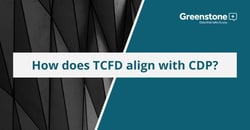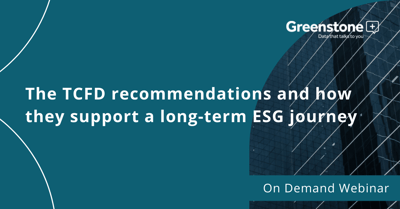How does TCFD align with CDP?
 The Task Force on Climate-Related Financial Disclosures (TCFD) was established by the Financial Stability Board (FSB) in 2015 to review how the financial sector could take account of climate-related issues. Chaired by Michael Bloomberg, the TCFD’s objective was to formulate a set of recommendations to help organisations understand and disclose their exposure to climate-related issues.
The Task Force on Climate-Related Financial Disclosures (TCFD) was established by the Financial Stability Board (FSB) in 2015 to review how the financial sector could take account of climate-related issues. Chaired by Michael Bloomberg, the TCFD’s objective was to formulate a set of recommendations to help organisations understand and disclose their exposure to climate-related issues.
Since then, the TCFD's recommendations have had a great influence in catalysing momentum for corporate sustainability action. For the past two years, for example, Larry Fink, BlackRock’s CEO, has stipulated in his annual letter to CEOs that companies should disclose climate-related risks in line with TCFD’s recommendations. At a national COVID-relief level, the Canadian government also tied large employer emergency financing to a requirement for companies to publish an annual climate‑related financial disclosure report.
In this blog, we delve into the main objectives of the TCFD recommendations and how they are aligned with CDP.
What are the TCFD recommendations?
The TCFD seeks to develop recommendations for voluntary climate-related financial disclosures that are consistent, comparable, reliable, clear, and efficient, and provide decision-useful information to lenders, insurers, and investors. It aims to enable stakeholders to allocate capital efficiently through the transition to a low-carbon economy without a potential dislocation of capital in the financial markets.
In 2017, the TCFD released climate-related financial disclosure recommendations intended to assist companies to provide more helpful information and promote informed capital allocation. The disclosure recommendations are structured around four thematic areas that outline key elements of how organisations operate:
- Disclosure of governance relating to climate-related risks and opportunities.
- Disclosure of actual and potential impacts of climate-related risks and opportunities on the organisation’s businesses, strategy, and financial planning.
- Disclose how the organisation identifies, assesses, and manages climate-related risks.
- Disclosure of metrics and targets used by the organisation to assess and manage climate-related risks and opportunities.
CDP's alignment with the TCFD
CDP acknowledges the role of the TCFD in mainstreaming climate-related information and advancing the availability of financially relevant information for global markets. Both CDP and TCFD encourage the integration of climate data into mainstream financial reports, providing transparency and a roadmap to meet the commitments of the Paris Agreement.
CDP has committed to aligning its questionnaires with the TCFD’s recommendations, alongside introducing a sectoral focus and embracing a forward-looking strategy to climate-risk disclosure. This harmonisation will help the adoption of TCFD recommendations by reporting companies, reduce the reporting burden, and speed up the generation of decision-useful information for data users.
CDP’s climate change questionnaire is aligned with TCFD recommendations and now contains over 25 TCFD-aligned questions. These questions are within the Governance, Risks & Opportunities, Strategy, Targets and Emissions modules. CDP's water security and deforestation questionnaires, inspired by the TCFD recommendations and organised in a similar structure, are also now covering topics such as Governance, Strategy, Metrics and Targets.
In a 2019 CDP survey on the extent that which companies are disclosing in line with TCFD recommendations, it was found that:
- 35% of companies provide information on all TCFD recommended disclosures through CDP.
- A further 34% respond to the majority (9-10 out of 11) of the TCFD recommended disclosures.
- 69% (over 1,700 companies) are thus disclosing information on at least 80% of the recommended disclosures.
CDP’s alignment with the TCFD signifies that CDP disclosing companies have ready-to-go material climate and natural capital disclosures that can be used for their annual reports. Many investors use CDP’s data to mitigate financial risk within their portfolios and select which companies are moving towards a climate-constrained future.
How Greenstone sustainability reporting software enables CDP and TCFD reporting
Greenstone is a Gold CDP software partner. Greenstone’s global sustainability reporting software has been designed to meet the requirements of CDP reporting and has a suite of dedicated tools to streamline the process. This includes GHG Protocol aligned data collection covering Scope 1, 2 & 3, climate change risks and opportunities, and an initiatives savings functionality for analysing savings against targets.
Greenstone’s Frameworks module, part of its Enterprise sustainability reporting software, has a TCFD tool to enable users to monitor Management Information and collect, analyse and report site-level climate change risks and opportunities. It also has award-winning framework mapping functions to be able to link SASB and TCFD content to other industry or company-specific frameworks (e.g. SDGs, UNGC, UNPRI).
Resources:
- Task Force on Climate-Related Financial Disclosures (fsb-tcfd.org)
- TCFD Knowledge Hub - TCFD Knowledge Hub (tcfdhub.org)
- On the 5th anniversary of the TCFD, a critical reminder to companies - CDP
- TCFD-overview - CDP
- CDP-TCFD-technical-note.pdf (rackcdn.com
- Greenstone's content library of TCFD updates and news
Additional content:
- CDP & TCFD Reporting: disclosing climate change risks and opportunities
- TCFD disclosure – where to start and how to align it with other frameworks
- Reporting the impacts of COVID-19 in your environmental reports
On Demand Webinar | The TCFD recommendations and how they support a long-term ESG journey










